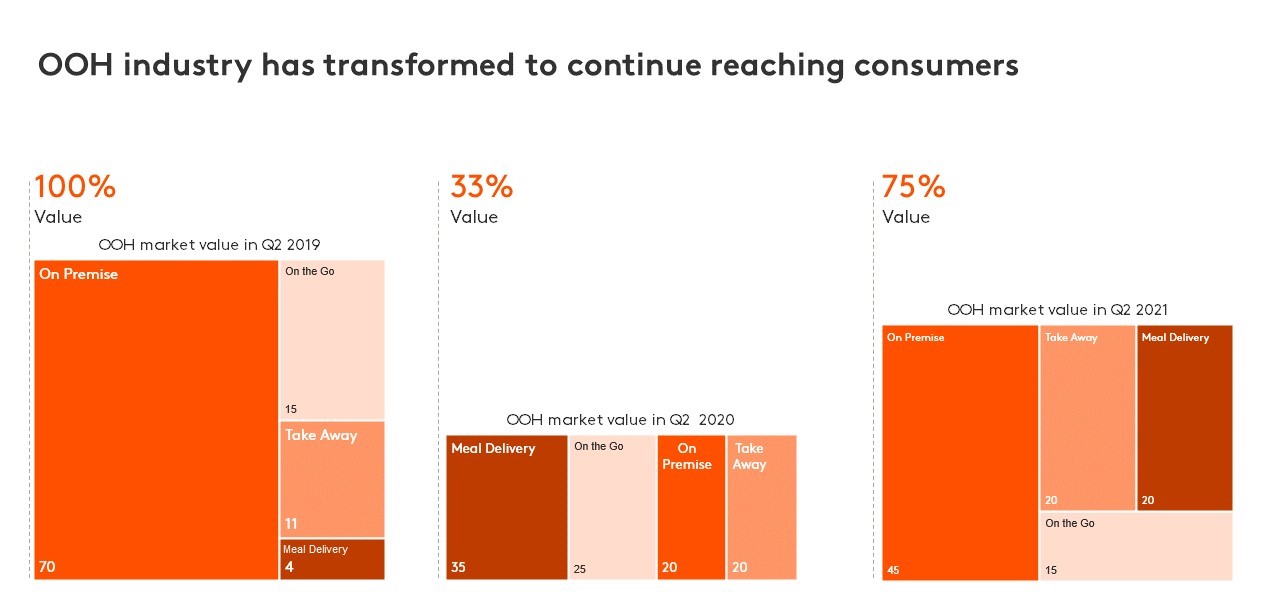Discover the biggest winners of the pandemic and get insight into how FMCG consumers’ behaviours may have permanently shifted. Our new findings show that, despite a rise in spending in out-of-home (OOH) outlets during the first half of 2021, meal delivery services and ecommerce continue to show sustained growth across markets.
Out-of-home spend in three key markets (UK, France and Spain) in Q2 2021 was more than double that of the same period in 2020 – but is still only at 75% of the levels seen in 2019. While spending in this area hasn’t yet fully bounced back, globally meal delivery services and ecommerce have seen a rise of 150% and 24%, respectively, in the year to June 2021.
These insights come from our “How Meal Delivery has transformed the Food Service industry” study, based on our Out-of-home consumer panel in 10 markets* and an additional survey of more than 15,000 consumers, and our Omnichannel report, which tracks the spending habits of consumers across seven key markets**.
Despite seeing record growth of 7.5% in 2020, in-home FMCG spend has dropped back to more normal levels, and sales are expected to grow by 2.2.% in 2021. The shift seems to be a result of increased OOH spending as societies around the world open up, with heavily vaccinated European markets like the UK, France and Spain driving this trend.
Meal delivery sees a boost
In contrast with 2019, the value of takeaway, on-the-go, and meal delivery consumption occasions have risen sharply, pointing towards a more varied and fragmented OOH market as consumers developed new habits. Accounting for a majority of sales at the height of the pandemic, meal delivery and takeaway have attracted more shoppers across all markets year on year, with the biggest rise in Portugal where there has been a 28% increase in penetration compared with 2020.
The biggest growth in the meal delivery sector is coming from consumers aged 50 and over, with penetration rising 43%, although consumption has risen across the board. Consumers in Asia lead the way in terms of frequency, with 35% in Thailand and 38% in South Korea reporting they order once a week or more.
Despite on-premise spend growing, meal deliveries, driven by third-party aggregators – particularly in Europe – are holding on to market gains. Consumers’ motivations for buying delivered meals are also changing. 35% of consumers now view getting food delivered as a treat for shared enjoyment, compared to 50% in 2019, with more people instead citing new and different consumption occasions – such as lunchtimes and meals for one – that have become part of their daily lifestyles.

Source: Kantar, Worldpanel Division, Out-of-home panels, June 2021
Beauty rises, homecare falls
Kantar’s Omnichannel study also shows that health and beauty spend has bounced back, from contributing to just 3% of all FMCG growth in 2020 to 36% in 2021, as social lives begin to flourish again. In contrast, the big winners of last year, homecare and cleaning, have dipped significantly, contributing -7% to FMCG growth.
Ecommerce holds onto growth but loses some gains
The pandemic has accelerated ecommerce growth in almost all markets, with spend growing 24% in the year to June 2021, and the channel largely holding onto its share gains from the big online transition of 2020. In 2019, ecommerce represented a 9.2% share of grocery shopping; in 2020, this increased to a peak of 14.5%, falling back slightly to 14.2% in 2021.
The strongest growth is seen in China with a 28% growth rate, despite high rates of vaccinations and lifting of restrictions. Europe has a much slower growth rate, with online sales growing at around 13% in the UK and just 3% in Spain, driven by more older shoppers heading back to stores.
2021 has been an interesting year for FMCG. It has seen consumers adapt out of lockdowns and heavy restrictions into more normal patterns of behaviour, so we’d expected to see an increase in out-of-home spending to reflect this. However, the continued growth in meal delivery and ecommerce has highlighted the importance of adapting to the unknown to find new growth opportunities. The fact that we are still turning to delivered meals as much as we did at the height of the pandemic points to a long-term behaviour change that presents opportunities for brands who are best able to provide for consumers’ new needs.
Read the report, watch the webinar in English or in Spanish, and reach out to our experts for more information or to purchase your category overview.
Notes
*Markets: UK, France, Spain, Portugal, Mexico, Brazil, Chinese Mainland, Indonesia, South Korea, Thailand
**Markets: UK, France, Spain, Chinese Mainland, Indonesia, Brazil and Mexico



